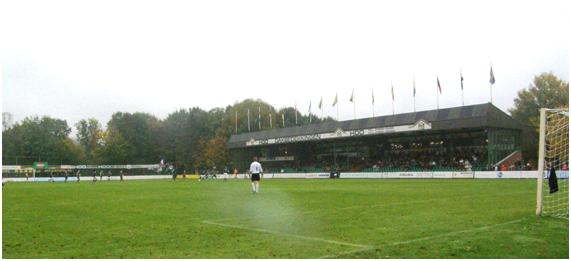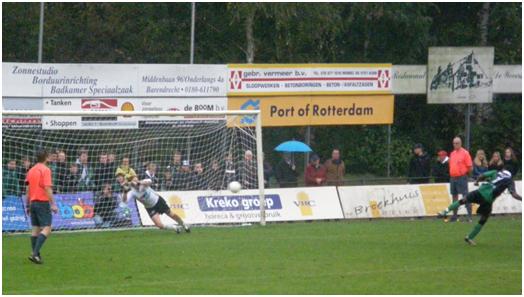Who wants to be Top Klasse in the Netherlands?
It was the summer of 2008 that FIFA added a section on promotion and relegation into their statutes. Even at the time, FIFA were quick to point out that the new rules would not be applied retrospectively. Hence although not in compliance with the regulations, no action will be taken against countries such as the USA, Singapore and Australia which use a franchise system and do not have direct promotion to their top divisions. The idea that FIFA was trying to nip in the bud was that of new European super leagues that could be created without any promotion or relegation. At the same time, FIFA directed that a club could not uproot and move, in the way that Wimbledon did before becoming MK Dons, or Clydebank becoming Airdrie United and numerous other cases in Eastern Europe. (The test of this still seems to be with local FA’s. Arles to Avignon (39km) having been acceptable this season).
To be honest, none of this makes much difference to the boys at the KNVB (Netherlands Football Association), who were already looking at ways to bridge the gap between the closed shop two divisions of their professional league, and the well organised double pyramid that in the amateur game. The Netherlands are unique in Europe in offering parallel, (generally equal) systems for non-League football, played on Saturdays and Sundays. Across Europe, the traditional day for playing football has a religious divide, with the Catholics of Italy and Spain being played on Sunday, while Protestants tend to play on Saturdays. The Netherlands however has a full structure of amateur football on both dates. The top level for this is currently the Hoofdklasse, which is divided into three regional groups, hence giving a total of six divisions, (three Saturday, three Sunday). Below the top level, the game is organised in six regions, unexcitingly called North, East, West 1, West 2, South 1 and South 2. Each of the six regions runs football from first class (one Saturday, one Sunday per region) down, and the regional cup competition (four teams from each regional cup on season qualify for the national cup the following year).
In one of the South zones, covering the area around Maastricht and close to the German border, there is a Sunday pyramid only, as this area has no Saturday teams
Regional and National cup competitions, and the final of the end of season amateur play offs are the only times that Saturday and Sunday teams meet and the rule is always that such matches are played on Saturdays. A Saturday team can always refuse to play on a Sunday.
As I have said, the KNVB have been looking for a way to bridge the gap between this system, and the two division professional league. Currently, teams move into the professional league by applying for a place, and proving that they have suitable facilities and finances for the higher level. There is no method for moving in the other direction, and the KNVB will not contemplate forcing a team to drop out of the professional league until there is a direct promotion available in the other direction. This is despite the fact that be allowing several new teams to join the league in recent years (Top Oss, AGOVV, Omniworld), while teams have not be dropping out, and mergers are no longer in vogue which means the lower division now has 20 teams, the KNVB would prefer both divisions to be 18. Until the start of the current century, there seemed to have been significant losses from the professional leagues teams dropping out for financial reasons, while others merged recently however, there have been no drop outs, and fans have started to transfer against mergers. Efforts last season merge Roda JC and Fortuna Sittard, both in financial trouble, failed due to supporters’ campaigns to keep their own clubs.
So, from next season, the KNVB plan is to introduce a new Top Klasse, above the Hoofdklasse. The Top Klasse will be a National Amateur League. Although of course it will be repeated for both Saturday and Sunday football. The end of season championship matches are therefore simplified. At the moment there are play-offs between the three Hoofdklasse champions to find the Saturday and Sunday Amatuer champions, but these will be unnecessary, leaving only the grand final to select the overall champion.
Promotion to the professional leagues will be limited to a single team, with only the two Top Klasse champions being eligible. If neither title holder wishes to apply for promotion, then no team will be relegated, but as the professional league currently has two more teams than it should, it has been decided that the bottom two sides from this seasons Professional League will be relegated into the new league. This has led to protests from clubs in the league, with the current bottom club, Emmen, saying that a relegation of this form would practically be the same as sending them into liquidation. Faced with this sort of bad publicity, the KNVB are now considering parachute payments, similar to those made to clubs relegated from the Football League to the Conference to help these clubs to keep on running. I am told the most likely result of this decision is that the clubs near the bottom of the league will go on a spending spree in the transfer window in an attempt to sign players to stave off the threat. This, of course will increase the debts, and I would be surprised if the crowds are increased by the anti-relegation fight. Nine of the 20 teams get less than 3000 per match, only 3 get over 5000.
Heerjansdam is a typical small town in the Netherlands, which means it is neat, tidy, very friendly to the cyclist, it is low rise and low key, with a bland shopping centre and of course, it has a football ground somewhere on the outskirts. This has a large stand on one side of the pitch, while the rest of the ground is surrounded by a level pathway. Like most amateur teams in the Netherlands, it stands as a true community club, apart from the first team, which is run as a semi-professional team and will recruit players in the same way as a team anywhere else, the club will run as many teams as it feels are necessary to meet the community’s desire to play football. For youth football, in every age group, this may mean running three, four or more teams. Quite simply, if you are a youngster in Heerjansdam and you want to play football, then you will play and be coached by this one club. It also means that if you run a business in the town, then either you, or some of your employees are sure to have an involvement in the club either directly, or because their children are involved. Hence most small businesses put a small amount of money into club sponsorship.

Sportpark de Molenwei, Heerjansdam. The clubhouse backs onto the stand, whereas there are further pitches behind the trees.
The away team for my game is ASWH a very local derby (they share a motorway intersection). Heerjansdam are in the 1st Klasse, Zuid 1 (after relegation last season), while ASWH are if Hoofdklasse A. The match is in the regional cup, and hence has the unwieldy title of Districktbeker Zuid 1, Round 1. Apart from local cup glory, the four semi-finalists from this competition will play in next season’s national cup. Although both sides for this match are from the Saturday leagues, the cup bridges date divide, and also has Sunday clubs in competition.
I am told that Heerjansdam had beaten their neighbours last season despite ending the season as relegated. I had been to ASWH in 2005, to see them become the Amateur champion of the Netherlands. [incidentally, the name stands for Altijd Sterker Wordend Hendrik-Ido-Ambacht. The last part of this is a placename whereas the first three words means something like “Always Becoming Stronger”. Such slogans are common in Netherlands football club names, and are perhaps the reason why clubs now prefer to be known only by initials]. Both clubs have made good starts to the season, but it took a while for this to notice on the field, or for either team to create a chance worthy of note. What was evident was a lot of progress being made on the wings, being ended by poor crossing. De Jager should have put the visitors ahead around 30 minutes in, missing a clear chance when the ball successfully made it to the far post, and then Heerjansdam created three good chances as the half came to a close. The first was blocked, but resulted in a corner, which for once was delivered into the danger area for centre half Gert-Jan Stout to bundle over the line. Jeroen Wolf should then have added a second in injury time, but he hesitated and allowed visiting keeper Jacob van der Belt to close down the chance.

The final (saved) penalty. Note the high number of advertising hoardings, a common feature of grounds in the Netherlands and Belgium.
ASWH came out for the second half with all guns blazing, and it was no surprise when substitute Henk Roeland brought the scores level; but in an already physical game, ASWH almost brought about their own downfall. Verluis was booked for a challenge in the 66th minute, and had to be restrained by his goalkeeper. Two minutes later with the ball out of play he was in trouble again and was fortunate to only get a second yellow and not a straight red. The game continued to be physical, and the referee ended up showing ten cards, but there were also plenty of chances for both sides in the second half but a couple of good saves including a tremendous dive by van den Belt in injury time, and a lot of timely blocks kept the scores level. The match then went straight to penalties, but the home side did not come good here, missing the first two, while ASWH hit three in a row. Van den Belt then saved the third to give the visitors a 3-0 penalty shoot out win.